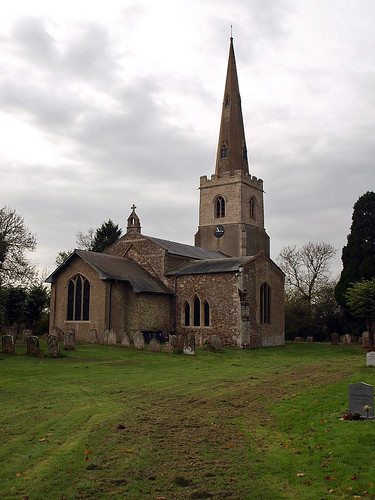ST PANDIONIA AND ST JOHN.* Quite a big church, considering the part of the county in which it lies. Built of pebble rubble. The chancel, alas, is of yellow brick and without any redeeming features. The church is essentially C13. The arcade of three bays comes first, with circular piers, capitals ranging from a row of upright leaves to complete early stiff-leaf, and slightly chamfered arches. The S doorway has an order of colonnettes and dog-tooth ornament in the arch. Nailhead ornament in the shafted inner arch of the N transept E window (the three lancets standing under this arch are C19). The chancel arch above is C13: demi-shafts as responds with moulded capitals and double-chamfered arches. Finally the W tower. The bell-openings, though renewed, seem to represent the original date: two lights under one arch with the spandrel left open. On the tower a spire of exceptionally good proportions and outline. It has two tiers of dormers, and their detail seems Dec. Perp tower arch, and (renewed) Perp S aisle windows. - MONUMENT in the N transept. Defaced effigies of husband and wife under a crocketed arch framed and embattled. The effigies can hardly be dated now.
* A Benedictine nunnery existed in the early Middle Ages at Eltisley, to which St Pandiana, a rarely remembered Early Christian English saint, had fled.
ELTISLEY. The charm of the village is its rare green like a velvet lawn, round which cluster the church, the thatched cottages, and (when the cricketers come out of their fine thatched pavilion) nearly all the village folk. There is shade for the onlookers under the chestnuts at three corners, and a row of limes in memory of six men who were missing when cricket began again after the war. There are two fine timbered houses, one the old rectory, and the other the birthplace of Major-General Disbrowe, who married Oliver Cromwell’s sister Jane in the church next door in 1636. We called on our way home from here to see two descendants of Jane Cromwell still living in a village of Huntingdonshire.
It is a small stone church, mostly 13th century, with a 14th century spire topping the tower, and a brick chancel which fortunately keeps the old arch. The pillars of the arcades with their leafy capitals are 700 years old, and there are two stone figures from the Middle Ages on a canopied tomb in the chapel. The knight has his hand on his sword but his feet are gone and his lady is headless. The plain old font has a pointed Jacobean cover carved with thistles.
The church’s unique dedication links John the Baptist with the Saxon saint Pandiana, daughter of an Irish king who fled from her lovers to Eltisley’s nunnery. The nunnery was removed to Huntingdonshire in the Conqueror’s day, leaving here only the outline of its moat among the pools, and in the 14th century the saint’s body was carried from beside the spring still called St Pandiana’s Well and buried in the church dedicated to her. St Wendreda, another obscure Saxon saint, whom we come upon again at March, is also said to have been buried in this church.
It is a small stone church, mostly 13th century, with a 14th century spire topping the tower, and a brick chancel which fortunately keeps the old arch. The pillars of the arcades with their leafy capitals are 700 years old, and there are two stone figures from the Middle Ages on a canopied tomb in the chapel. The knight has his hand on his sword but his feet are gone and his lady is headless. The plain old font has a pointed Jacobean cover carved with thistles.
The church’s unique dedication links John the Baptist with the Saxon saint Pandiana, daughter of an Irish king who fled from her lovers to Eltisley’s nunnery. The nunnery was removed to Huntingdonshire in the Conqueror’s day, leaving here only the outline of its moat among the pools, and in the 14th century the saint’s body was carried from beside the spring still called St Pandiana’s Well and buried in the church dedicated to her. St Wendreda, another obscure Saxon saint, whom we come upon again at March, is also said to have been buried in this church.

No comments:
Post a Comment